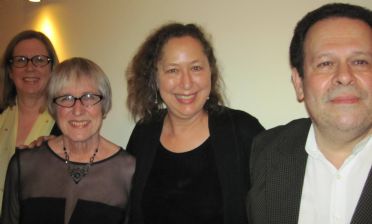|
Symphony
SRS SEASON ENDS WITH RESOUNDING TA-TA-TA-BANG
by Terry McNeill
Sunday, June 1, 2025
Symphony
YOUTHFUL VIRTUOSITY ON DISPLAY AT USO'S MAY CONCERTS
by Peter Lert
Saturday, May 17, 2025
Symphony
MYSTICAL PLANETS AND LIVELY GERSHWIN ORTIZ AT FINAL SRS CONCERT
by Peter Lert
Sunday, May 4, 2025
Symphony
VSO'S CONCERT MUSIC OF TIME, MUSIC OF PLACE
by Peter Lert
Sunday, April 27, 2025
Choral and Vocal
VOCAL ELEGANCE AND FIRE AT THE 222'S RECITAL APRIL 26
by Pamela Hicks Gailey
Saturday, April 26, 2025
CANTIAMO SONOMA SINGS AN INSPIRED GOOD FRIDAY MOZART REQUIEM CONCERT
by Pamela Hicks Gailey
Friday, April 18, 2025
DRAMATIC SHOSTAKOVICH SYMPHONY CLOSES PHILHARMONIC'S 25TH SEASON
by Terry McNeill
Sunday, April 13, 2025
LARGE COLLEGE OF MARIN AUDIENCE GREETS STOPHER ARTISTRY
by Terry McNeill
Saturday, April 5, 2025
Chamber
FRISSON DELIVERS SHIVERS OF DELIGHT
by Abby Wasserman
Sunday, March 30, 2025
OLD AND MOSTLY NEW IN SRS MARCH CONCERT IN WEILL
by Peter Lert
Saturday, March 22, 2025
|
 |
 (l to r) Ellis, Thompson, Brindel and Romasevich Backstage in Weill |
DISCOVERY ANEW FOR THE NAVARRO TRIO IN WEILL
by Terry McNeill
Sunday, November 24, 2013
A major part of the Trio Navarro’s approach to chamber music has been discovery, as over many years they have explored novel (if not new or radical) corners of the small ensemble repertoire. November 24’s concert in Weill Hall was no exception as an unfamiliar piano quartet and trio were the evening’s most intriguing offerings.
Georgy Catoire’s lively and atmospheric A Minor Quartet opened the concert, and the Trio’s Victor Romasevich (violin), cellist Jill Rachuy Brindel and Marilyn Thompson (piano) were joined by violist Nancy Ellis. A frequent past guest, Ms. Ellis seamlessly blended with her colleagues in the unique fabric of Catoire’s music. The hothouse character of the quasi Wagner and late romantic score was in the first movement constantly reminiscent of Schoenberg’s orchestrated version of the tone poem Verklärte Nacht from 1917. This is surging and sexy music.
As in recent Navarro concerts Mr. Romasevich sat in for perennial stalwart Roy Malan, and elicited a different high string sound. His tone throughout the Catoire is not as wide and vibrato-laden as from Mr. Malan, but has a penetrating quality that easily stood out from the two lower string instruments. He also didn’t take several phrase-opening notes cleanly but as the work moved into the final Allegro he was sure-footed and sonorous. The ending gave hints of Ravel’s music and the unexpected tempo acceleration brought the 1916 piece to a ringing if not loud conclusion.
Mr. Romasevich was again in the forefront of a performance of Josif Andriasov’s C Minor Trio, Op. 7, as he had been a student of the composer and is a champion of Andriasov’s music. In quirky ways the 1957 Trio was aligned with some of the Catoire Quintet harmonies, although the Trio is a darker and more compelling work. In the first Allegro movement the ensemble playing was admirable, the violin line soaring often into the highest register even during several bucolic sections. The second movement had references to Shostakovich and Mieczyslaw Weinberg and was idiomatically played, as were the slow march motives of the finale.
Both the Catoire and Andriasov works demand of the listener an acceptance of a string and piano fabric of sound rarely encountered, and might not be to everyone’s taste. I found all the music persuasive and energetically performed.
No such lack of aquaintence came with the concluding work, Schumann E-Flat Major Quartet, Op. 47. The tempos throughout the four-movement piece from 1842 were judicious and Ms. Thompson’s deft playing captured Schumann’s bittersweet melancholy. The dynamic Scherzo featured some of the best string playing of the concert, the violin notes carrying to the back of the sparsely-attended hall and Ms. Brindel’s cello line was opulent. In the Andante’s “heart on sleeve” principal theme Ms. Ellis carried on fetching duos with Ms. Brindel and Mr. Romasevich, and the slow counterpoint was beguiling. There was no rush to get anywhere and the four musicians were comfortable giving each of their colleagues a turn at voice leading.
The Vivace finale was played without undue hurry but with Ms. Thompson forging ahead several feverant climaxes were built and the Quartet’s conclusion was decisive
|

